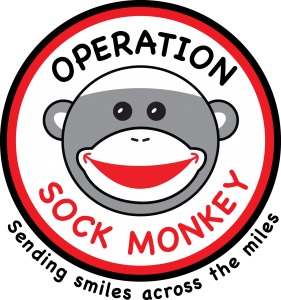
Who: Operation Sock Monkey
What: Making, Adopting, Sponsoring a Sock Monkey for a Child
Where: Everywhere
Operation Sock Monkey’s mission is:
Operation Sock Monkey is a volunteer-run initiative in support of humanitarian organizations that provide laughter, hope and healing to communities around the world affected by disease, disaster and social/political turmoil. Handmade Sock Monkeys can be purchased or sponsored to be sent to children in need of a smile.

How to Help: (text from here)
Donate a Monkey: Send us your sock monkeys and we’ll find them good homes. Monkey delegates are sent to live in communities in distress to help bring smiles to folks who need them. (You can learn how to make a sock monkey here!)
Adopt a Monkey: Buy an OSM Sock Monkey and we’ll donate the proceeds to Clowns Without Borders. We have a variety of sock animals for children of all ages. Visit the sock zoo.
Sponsor a Monkey: buy a sock monkey sponsorship and we’ll send a sock monkey to someone in need of a smile. You will receive a colorful sponsorship card that can be given as a gift. (Check out the Sponsorship Gallery here!
Buy OSM Treats: Specialty items like notecards, calendars and D-I-Y kits for making your own sock animals at home! All proceeds go to CWB, of course.
Donate to OSM: We’d be happy to accept donations for monkey supplies and shipping, but we also recommend donating to Clowns Without Borders directly by clicking here. (You can buy OSM treats here!)
Become an OSM Operative: Start up your own Operation to make and sell sock monkeys in your community to benefit CWB or the charity of your choice.
To find out more, check out the Operation Sock Monkey website (you can also find out how to hold a OSM workshop or party here) or visiting them on Twitter, @woollybananas.



